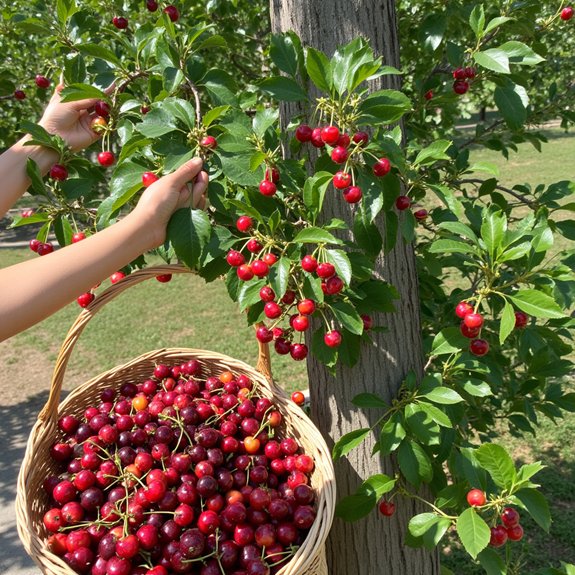Have you ever wondered why some cherry trees produce abundant fruit while others barely yield enough for a single pie? You’ll discover that successful cherry cultivation hinges on selecting compatible varieties, timing your planting perfectly, and understanding the intricate balance between sunlight, water, and soil conditions. Most gardeners make three critical mistakes during their first year that can doom their trees for decades, but there’s a surprisingly simple sequence of steps that virtually guarantees success.
Contents
- 1 Understanding Cherry Tree Varieties and Identification
- 2 Optimal Planting Timing and Techniques
- 3 Creating Ideal Growing Conditions
- 4 Essential Maintenance and Pruning Practices
- 5 Harvesting and Utilizing Your Cherry Crop
- 6 Attracting Wildlife to Your Cherry Trees
- 7 Managing Common Pests and Diseases
- 8 Safety Considerations and Toxicity Awareness
Understanding Cherry Tree Varieties and Identification

Before you plant your first cherry tree, you’ll need to understand the two main types that dominate home orchards. Sweet cherries (Prunus avium) are perfect for fresh eating, while sour cherries (Prunus cerasus) work best when cooked into pies or jams. Your variety selection should include trees that bloom simultaneously for better pollination.
Tree identification becomes easier once you know what to look for. Younger cherry trees display glossy bark with distinctive horizontal lines called lenticels. Older specimens develop rough, bumpy calluses and show a twisted, knotted appearance that helps determine their care needs.
Optimal Planting Timing and Techniques
When should you plant your cherry tree for the best chance of success? Early spring offers ideal conditions when soil becomes workable. Before planting, focus on proper soil preparation by choosing well-drained, nutrient-dense ground that won’t waterlog your tree.
Start by watering your potted tree thoroughly, then dig a hole twice the root ball’s size. Cherry tree spacing matters—give sweet cherries 20-25 feet between trees, sour varieties need 15-20 feet. This prevents overcrowding and guarantees adequate airflow.
After positioning your tree, apply a 1-2 inch moss layer around the base for extra protection and moisture retention.
Creating Ideal Growing Conditions

Since cherry trees demand specific environmental conditions to thrive, you’ll need to focus on three critical factors: sunlight, watering, and soil quality. Your trees require 6-8 hours of full sun daily for proper flowering and fruiting. Insufficient light exposure prevents fruit development entirely.
Water twice weekly during the first three years, monitoring soil moisture carefully. You’ll want to avoid both drought stress and waterlogging, which damage root systems.
Soil quality matters most—use well-drained, nutrient-dense earth. Cherry trees prefer temperate climates without extreme temperature swings, so apply mulch around the base for protection.
Essential Maintenance and Pruning Practices
Proper maintenance starts with regular pruning, which keeps your cherry trees healthy and shapes their growth effectively. You’ll want to establish a maintenance schedule during the first two years, focusing on heading cuts that remove ⅓ to ½ of branch length. Make these cuts at 45-degree angles to prevent damage and encourage lateral growth.
Remove suckers and weak branches regularly to improve nutrient distribution throughout the tree. Aim for an open vase shape that enhances light and air exposure. These pruning techniques create scaffold whorls by selecting strong lateral branches, which you’ll repeat yearly while maintaining proper spacing.
Harvesting and Utilizing Your Cherry Crop

Although you’ve invested months nurturing your cherry trees, the real reward comes when those vibrant red fruits signal harvest time. Sweet cherries reach peak ripeness when they develop their classic red color, but taste-test them to be sure. Sour cherries detach easily from branches when ready.
Always leave stems attached during picking to protect the fruiting spurs for next year’s crop. Fresh sweet cherries stay crisp when chilled, while tart sour varieties excel in cherry recipes like pies and cobblers. Preserving cherries through canning, jam-making, or freezing extends your harvest beyond the typical ten-day fresh storage window.
Attracting Wildlife to Your Cherry Trees
When your cherry trees begin producing fruit, you’ll discover they’re natural magnets for wildlife that can enhance your garden’s ecosystem. Various bird species, including robins and cardinals, will flock to your trees for the sweet fruit. This creates excellent pollinator attraction opportunities, as birds help spread pollen between blossoms during feeding.
You’ll also notice butterflies and ladybugs visiting your cherry trees regularly. The presence of these creatures indicates a healthy tree environment. Birds actually aid in cherry blossom pollination, making them beneficial garden partners rather than just fruit thieves.
Managing Common Pests and Diseases
While wildlife brings life to your cherry trees, pests and diseases can quickly turn your thriving orchard into a problem zone. Effective pest identification starts with regular monitoring during late winter and spring.
Cherry leaf spot, a major fungal threat, requires collecting fallen leaves each autumn for disease prevention. Black cherry aphids cause twisted leaves, so encourage natural predators like ladybugs. Powdery mildew needs improved airflow and organic sulfur fungicide treatment.
Watch for borers boring into trunks, white Prunicola scale patches, and hard black knot bunches. Remove infected branches immediately, clean debris regularly, and maintain overall tree health through proper watering and pruning practices.
Safety Considerations and Toxicity Awareness
Beyond the challenges of pests and diseases, cherry trees present hidden safety risks that many gardeners don’t realize. Cherry leaves, stems, and blossoms contain cyanogenic glycosides, compounds that prevent cells from absorbing oxygen properly.
Pet safety becomes essential around these beautiful trees. Dogs and cats who chew on fallen branches or leaves may experience toxicity symptoms including difficulty breathing, dilated pupils, and bright red gums. Clean up fallen debris regularly, especially during pruning season.
Supervise pets during outdoor time near cherry trees. While the fruit itself is safe, other plant parts pose genuine risks to curious animals.
